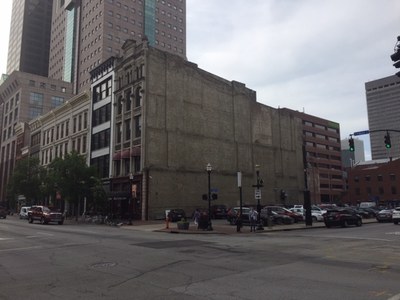SPHIS Home » News » A Brief History of the First School of Public Health at the University of Louisville
A Brief History of the First School of Public Health at the University of Louisville
By: Richard W. Wilson, DHSc, MPH, professor, Department of Health Promotion & Behavioral Sciences
Abraham Flexner
In the middle of the Health Sciences Center campus of the University of Louisville is a street, Abraham Flexner Way, commemorating a Kentucky native son who was instrumental in bringing academic standards to U.S. medical education, early in the 20th Century. Dr. Flexner is famous for his Flexner Report (1910) that initiated a movement to eliminate substandard and unqualified proprietary medical schools that were rampant at the time. Less known is that Abraham Flexner was also a national leader in the formation of the new and distinct profession of public health. In the second decade of the 20th Century, Flexner served as Secretary (e.g. Director) of the Rockefeller Foundation General Education Board. This board had taken on the task of enhancing the supply of public health workers, particularly for the Southern states, and with time, became instrumental, with Flexner’s leadership, in bringing about standards and recognized practices for the evolving new schools of the day, including Harvard, MIT, Michigan, Pennsylvania, Yale, and Johns Hopkins, whose public health academic programs were established 10-20 years into the 1900s. U of L was part of that group, at least for a while.
While Dr. Flexner was born (and is buried) in Kentucky, there is no evidence to suggest that he played an active role in public health developments in the Commonwealth. However, his leadership most certainly would have come to the attention of the key players of the Kentucky public health workforce at that time. These leaders were well travelled in public health circles, and would have known about concepts and principles promulgated by Flexner’s General Education Board. For example, there was a national debate in academic public health regarding the relative importance of practical training as opposed to research training, an idea that was settled among the founders of the school to be established in Louisville. They wanted to prepare public health practitioners, first and foremost.
Moving forward, we come to the year 1919. The 1st World War had officially ended with the Treaty of Versailles. National alcohol prohibition was initiated with the 18th amendment and voting was guaranteed to women by the 19th amendment. The nation was absorbing a massive movement of immigrants from Europe and numerous infectious diseases, such as tuberculosis, diphtheria, typhoid fever, pertussis and smallpox were leading causes of death. The year was right in the middle of the Spanish Flu pandemic that caused the death of up to 100 million people worldwide, posing a huge Kentucky public health challenge as well. The State Board of Health was persuaded by the U.S. Public Health Service to issue a proclamation to close all schools, bar public assembly, avoid church gatherings, and to shutter places of amusement until the epidemic was over. This is backdrop for the University of Louisville to establish a school of public health to serve needs in Kentucky and beyond.
The public health enterprise of the day was growing at local, state and federal levels. It was the age of bacteriology, so that public health efforts were focused on sanitation and interrupting the seemingly indomitable infectious diseases. Leaders and officials struggled greatly to recruit physicians and other workers to go up against the contemporary public health challenges. Public health leaders were convinced that the time was right to grow academic public health, to provide professionals for state and local health departments.
The toolbox of public health was still in its infancy, and the public health workforce consisted mostly of Health Officers (usually physicians, mostly part time volunteers who led health departments and local boards of health), public health nurses, lab technicians and sanitary inspectors. Health education was increasingly recognized as an essential activity, though it was seen through the lens of dispensing health information, without the theoretical insights that would come in later years.
The School of Public Health at the University of Louisville was a collaboration between the Kentucky Board of Public Health and the University. Recall that the University was a private institution at the time, much more limited in resources and academic offerings than what exists today. Other partners included the School of Medicine, the Louisville Normal School (established for training of teachers), University of Louisville Arts and Sciences, the American Red Cross, the Kentucky Tuberculosis Association (an affiliate of what would become the American Lung Association) and the Louisville Public Library.
The founding Dean of the School was Arthur T. McCormack. For many years he served as the secretary of the Kentucky State Board of Health, at the time equivalent to what we now call the Commissioner of the Department for Public Health. Dr. McCormack was energetic and activist, and led the effort to establish the School with the financial and personnel support of the State Board of Health. His vision was to integrate the academic program to practical training with public health agencies in the Commonwealth. He was the broker to complete the purchase (for $33,100) of a building in downtown Louisville, 6th & Main St., to serve as the headquarters of the State Board of Health as well as facilities for the School of Public Health. In addition to his role as Dean and principal public health official, Dr. McCormack served as president (not simultaneously) of the American Public Health Association, the Southern Medical Association, and the Association of State and Territorial Health Officials.
The School opened in 1919 with 38 students, offering a Doctor of Public Health degree and certificate programs for public health physicians, public health nurses, sanitary inspectors, and laboratory technicians. Enrollment records are spotty and uncertain, however, as many as 46 students were enrolled in a single year, and for several years, 15-25 public health nurses graduated from the certificate program. By 1923, enrollment was waning. Academic governance records document discussions to discern reasons why the expected demand for the public health offerings hadn’t materialized. The curriculum and fees were considered; total tuition for the certificates for health officers and public health nurses was $65.
Shortly after this, the coursework for physicians was absorbed by the School of Medicine and the Louisville School of Public Health came to an end. It would be 80 years before the School of Public Health would come to life. In the interim, no formal public health training was provided in the Commonwealth, though several schools, including U of L, provided training for health teachers working in the public school system. One wonders how much of the current state health disparities might have been avoided if a dynamic training for public health workers in Kentucky could have been sustained through all those years.
(Below) Location of the original School of Public Health at the southeast corner of 6th & Main in Louisville.  Old building demolished.
Old building demolished.
- Board of Health Purchases Home. The Courier Journal (Louisville, KY). March 10, 1921, p. 7.
- Bulletin of the State Board of Health of Kentucky. School of Public Health, University of Louisville. Announcement 1922. Vol XI, December, 1921, No. 5. Retrieved from Kentucky State Archives, Frankfort, KY.
- Fee, Elizabeth and Acheson, Roy, eds. A History of Education in Public Health: Health that Mocks the Doctor’s Rules. New York; Oxford University Press, 1991.
- Minutes, Kentucky State Board of Health Meetings, 1917-1925. Retrieved from Kentucky State Archives, Frankfort, Kentucky.
- Rosen, George. A History of Public Health. New York; MD Publications, Inc. 1958.
- Wikipedia. Arthur T. McCormack
- Wikipedia. Abraham Flexner
Acknowledgement
Many thanks to Mary K. Marlatt, archivist in the Kornhauser Health Science Library, for her research assistance.






